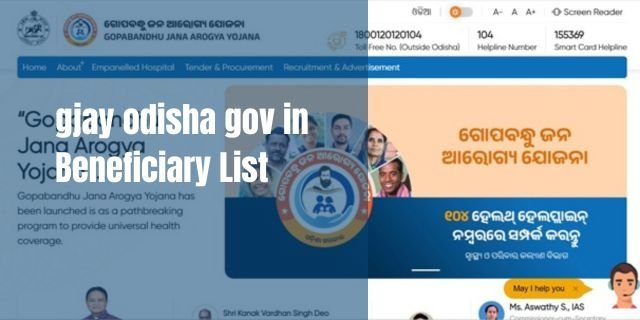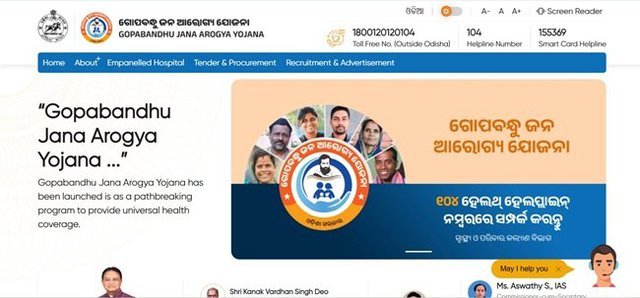The Gopabandhu Jana Arogya Yojana (GJAY) was started by Odisha government to help poor families who need money for hospital treatment, and many people has been added in this scheme. A website called gjay.odisha.gov.in was made where names of people are put in the Beneficiary List, and this list can be checked by anyone. If someone’s name is there, it means free treatment can be got from hospitals. The list was uploaded so people can know easily. GJAY was also joined with Ayushman Bharat scheme to give more health benefits, and now more families is being helped. This was done so that no poor person be left untreated.

What is Gopabandhu Jana Arogya Yojana?
Gopabandhu Jana Arogya Yojana, also called G-JAY, is a health scheme started by the Odisha government and it was before known as Biju Swasthya Kalyan Yojana which helped many people. The scheme was made so that all people in Odisha can get free health services at government hospitals like subcentres, CHCs, and district hospitals. About 70 lakh families has been added in this scheme and free treatment is being given to them. Every year, Rs. 5 lakh is given to each family and Rs. 7 lakh is given if the patient is a woman, so women are helped more. This scheme was also joined with Ayushman Bharat, so now more poor families is getting good treatment without paying any money.
Also Read: Odisha Elderly Pension Scheme
Key Highlights of gjay odisha gov in Beneficiary List
| Name of the Article | gjay odisha gov in Beneficiary List |
| Launched by | Odisha Government |
| Objective | To provide free health care for families |
| Coverage | Rs. 5 lakh per family yearly |
| Extra Coverage | Rs. 5 lakh for women |
| Beneficiaries | Around 70 lakh families |
| Hospitals | Govt and private included |
| Treatment | Cashless and free |
| Health Card | Single card for all benefits |
| Grievance System | District, state, national |
| Digital System | Fully online and easy |
| Beneficiary Check | Via official website |
| Official Website | GJAY Website |
Benefits of Gopabandhu Jana Arogya Yojana
The benefits of Gopabandhu Jana Arogya Yojana are as follows:
- Rs. 5 lakh health coverage is given every year to each family.
- Women members get extra Rs. 5 lakh, so total Rs. 10 lakh can be got if women is there.
- Free and cashless treatment is given in empanelled government and private hospitals.
- More hospitals are added, so people can get treatment even outside Odisha.
- One health card is given because GJAY is joined with Ayushman Bharat scheme.
- All senior citizens above 70 years get free medical treatment, no matter their income.
Also Read: Kalia Yojana List
Required Documents
These are the required documents for GJAY application, which are as follows:
- Aadhaar Card or Aadhar Registration Slip
- Proof of Residence
- Family Information with Aadhaar numbers
- Caste Certificates (if applicable)
- Journalist Accreditation Certificates, Appointment Letters, Employment ID (if applicable)
- For Odisha Journalists: Birth/Matric Certificate, Voter Card, PAN Card, Passport or Driving License, and Delhi Address Proof (if working in Delhi)
Salient Features
The scheme has several important features, which are as follows:
- Health coverage is given to all families in Odisha.
- Free health services are provided at government hospitals and centers.
- Rs. 5 lakh yearly coverage is given to each family and extra Rs. 5 lakh for women members.
- GJAY is joined with Ayushman Bharat scheme to give more help and more hospitals.
- Cashless treatment is given in over 29,000 hospitals, both government and private.
- Complaints are solved by a system at district, state, and national levels.
- The whole scheme is digital, so it works faster and easier for people.
Also Read: Odisha Mukhyamantri Shiksha Puraskar Yojana
How to Search gjay odisha gov in Beneficiary List?
To Search gjay odisha gov in Beneficiary List, please follow these below mentioned steps:
- Step 1: All the citizens of the state who have already applied for the scheme, can go to the GJAY Website to check the beneficiary list.

- Step 2: You will reach the homepage of the official website, scroll down the page a little bit and click on the “Beneficiary List” option to proceed further.

- Step 3: Now on another page, select State, district, block name, GP name, and then enter mobile number carefully.
- Step 4: Check carefully the entered details and then click on the “Search” button to move ahead.
- Step 5: The gjay odisha gov in the Beneficiary List will appear on your screen, you can download this list and keep it in your device for future reference.
Detail Mentioned Under Beneficiary List
The details mentioned under the Beneficiary List includes:
- Name of the beneficiary
- Aadhaar number
- Mobile number
- Address details (State, District, Block, GP)
- Family member details
- Scheme enrollment status
- Date of inclusion in the scheme
- Contact information
Helpline Number
Location:
- A1 Block, 2nd Floor Toshali Bhawan, Satyanagar
- Unit – 9, Bhubaneswar,
- Pin – 751007, Odisha.
Contact Number:
- 0674-2620500
Mail:
- snaodisha[at]gmail[dot]com
- bsky[at]odisha[dot]gov[dot]in
FAQs
What is Gopabandhu Jana Arogya Yojana (GJAY)?
GJAY is a health insurance scheme started by Odisha government, it gives free medical treatment and financial help to poor families so they can get good healthcare without paying money.
Who can get benefits under GJAY?
All families living in Odisha can get benefits especially poor families and women get extra help, also people above 70 years get free treatment no matter how much money they have.
How much health coverage is given under GJAY?
Each family gets Rs. 5 lakh for health expenses every year. Women members get extra Rs. 5 lakh, so families with women can get up to Rs. 10 lakh coverage yearly.
How can I check if I am a beneficiary of GJAY?
You can check on the official website gjay.odisha.gov.in by clicking on Beneficiary List, fill in your details like district and mobile number to see if your name is there.
Is treatment under GJAY really free?
Yes, the treatment is completely cashless and free in many government and private hospitals that are part of the scheme and you don’t need to pay anything for covered treatments.